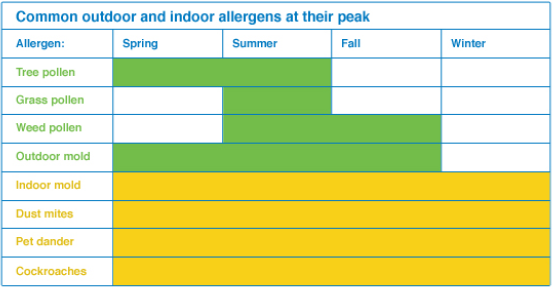Identifying your allergens
Nasal allergy symptoms can be triggered by indoor (or year-round) or outdoor (or seasonal) allergens. Knowing which allergens you react to can help you and your health care provider create a plan for limiting your exposure, and potentially, your symptoms.
Indoor (year-round) nasal allergy symptoms can persist year-round and are caused by indoor allergens like mold, dust mites, cockroaches, and animal dander. These allergens can be present in pillows and bedding, draperies, upholstery, thick carpeting, on your clothing, on your pets, and in moist areas of your home like bathrooms and basements.
Outdoor (seasonal) nasal allergy symptoms are very common and are usually caused by allergens that appear at specific times of the year, with some variation due to weather. In the spring, tree pollens are a common trigger. From late spring to summer, grasses enter the scene. Weed pollens including ragweed start becoming a problem for some people in the summer, and peak in the fall. Finally, throughout the year in many states, but especially after a spring thaw, outdoor mold spores are a trigger. Outdoor molds are very common, found in soil, some mulches, fallen leaves, and rotting wood.
It’s possible to be affected by more than one allergen of either or both types, but here’s a quick way to sort through them.

A few things to keep in mind
• You may be reacting to more than one type of allergen. For example, having nasal allergies to both trees and grass can make your symptoms worse during the summer, when both of these pollens are high.
• Mold spores are another allergen that can cause problems in the fall, especially if you are raking leaves or doing yard work. Molds grow in dark, wet places and can disperse in the air if you rake or disturb the area where they’ve settled.
• People with indoor nasal allergies can be bothered by outdoor nasal allergies as well. You may need ongoing treatment to help relieve indoor nasal allergy symptoms.
Your health care provider can help you pinpoint what you are allergic to, and tell you the best way to treat your nasal allergy symptoms. Provide detailed information about your lifestyle and habits to your health care provider it will help him or her provide you with an appropriate treatment plan for relieving your symptoms.
Source: Nasal Allergies Resource Center
